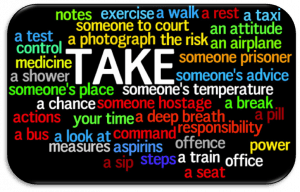Collocate: The Importance of Teaching Collocations
When I was invited to write the article for this magazine, I thought it would be a great opportunity to offer some of the experience I have gained in my role as a teacher for the last 22 years. All those years ago, I would never have imagined that I would be writing such an article. You see, back then in my native homeland of Greece, resources were scarce, technology was not pervasive enough and, even though I was so eager to impart knowledge, I had neither the experience nor enough time.
As for games well, I wasn’t too interested in them either physically or online. I could describe my attitude towards them as lukewarm. Actually, I hadn’t realized how important games were and I deemed that covering the syllabus of different courses would have to be the main goal.
However, as I have developed as a teacher, so has my attitude towards games, and now they constitute a wonderful addition to my classes and through games, my students welcome the opportunity to practice their speaking and communicative skills, whether they are at a beginner or advanced level.
A certificate is the be all and end all
Getting a certification in the English language was not of primary importance to me but in Greece where I teach, getting a certification is the ultimate goal for every learner; there are 24 (!) different examination bodies with certifications which cater for every taste and level, but make no mistake: the bearer is not automatically turned into a beacon of knowledge.
Unfortunately, due to fierce competition, much foreign-language learning in Greece is exam-oriented with the majority of students aiming to score a pass in standardised tests, rather than increase their authentic learning and critical skills. I dare say that nowhere else in the world is there such a plethora of simplified certifications. I am convinced that this will lead us to a generation of demotivated students who will take for granted that just their success in language exams is enough to secure a place in the professional world.
However, as teachers, we know that this is not enough. Should we not make a pledge to ourselves that lessons should be thought-provoking, realistic and meaningful every day to help our students survive in English in the real world? I believe that considerate teachers should try to expose their students to real-life situations, stir their imagination and help them come out with utterances in a natural way.
In my experience, I have found that most students tend to translate from L1 to L2. Sometimes it helps but wherever possible I try to persuade my students to avoid doing this and to find other ways of understanding and remember the meaning of a word and to help them I came up with the following idea:
An idea was born
I came up with the idea for a collocations project. Collocations are everywhere! They are the compelling evidence that authentic language is used and they maximize the development of learners’ communicative competence.
I swear by collocations
I have been testing them for many years with my proficiency classes and I have come to the conclusion that only by building blocks of phrases will my students be able to make use of them in their oral or writing productions (example: adverse effects). Even in Ted Talks or films, I get my students to note down and make a list of the collocations they come across. Then, when we set out to elaborate on an issue, they can draw on the list which we have already compiled. Some collocations are so well known that they simply roll off the tongue.
Some would argue that this is a kind of prefabricated language, which is not conducive to producing spontaneous utterances but make no mistake, it is actually the springboard for generating ideas and it bears fruit in the long run. Besides, research has shown that as long as learners are able to assimilate language chunks, they are bound to develop deep strategies for their vocabulary acquisition.
Time to Implement the Collocations’ Project to My Young Learners
Having all the above in mind and striving to help my students internalise knowledge, I conceived of a way to put into practice what I thought would be the partial solution to retaining new vocabulary. The project was actually divided into four phases. Below are the explicit instructions.
I handed out to my learners a leaflet of instructions so that they could follow step by step what had to be done. There was actually a fundamental rule: they had to keep a record of every collocation they came across in their books, workbooks, transcripts etc and if possible they had to highlight them. Then, we made out a list of all these collocations. At home, they copied the two parts of the collocations in a special notebook with blank pages. I had actually divided the notebooks into two parts so that they could write each segment of the collocation on a different page in a random order. After that, they coloured the segments of each collocation with the same color.
In this way, students can revise by themselves by flicking through their notebooks and looking at the segments with the same color. They can also do so by showing one another their notebooks and exchanging them and the vocabulary revision is carried out at a quick pace in a fun way. It can also be played as a game. Set a time limit and a race among the teams may start whereby each team tries to find as many collocations as possible.
Other Ways to Teach Collocations
There are so many practical ways to teach collocations in a fun and quick way. I make very good use of post-it notes: In one game I write one half of the collocation and the other on a different post-it. Then I stick one of them to the back of one student and one to another. Students are not allowed to look at their post-it. They have to go around the class and ask each other what their post-it on their back says and of course they have to find their match.
Collocation Charades and Dictogloss are also brilliant and work wonders when it comes to collocation revision. The British Council gives loads of practical guidance on how to use collocations in class. Undoubtedly, there are applications for the technophiles such as Quizlet. There is actually so much under the sun to choose from that I have to admit I am spoilt for choice.
Do not be deterred by the volume of workload: just keep searching and try to apply and adopt material for your class, which best works for your students, keeps them happy and encourages them to use authentic language.
The Greek Harsh Reality and Final Thoughts
In conclusion, I would like to mention the hardship which Greece as a country has gone through economically and how it has impacted on teachers and owners of language schools. Austerity measures have been harsh and demotivating for all, and, in order for us teachers and language school owners to stay afloat in the competitive Greek market after all the hardships we have gone through, we as educators have had to exert ourselves, keep our minds very focussed and never be guilty of complacency, nor giving in to mediocrity just because our businesses are in jeopardy due to financial recession and overtaxing. On the contrary, we should endeavour to be innovative and generate new ideas, to implement new practices with out students, always being one step ahead. Unless you are willing to do so, unless you are passionate enough to change your students’ world, please do not bother embarking on a teaching career. Closing, I would like to cite my three most favourite mottos:
Once a teacher always a learner.
When you are tired of learning you are tired of life.
The harder I work, the luckier I become.




